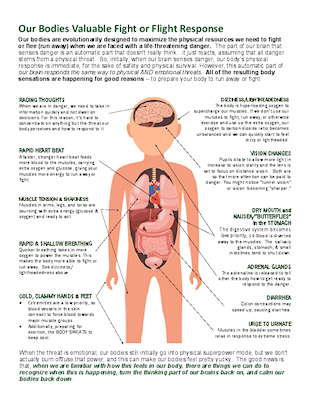Daily Archives: August 24, 2016
Panic Attacks Part 1: What is Panic & Why We Need It share
Panic is a normal, necessary physical response to the brain perceiving a significant threat. It involves the release of a hormone that you are likely familiar with, adrenaline. Adrenaline’s job is to tell the body to make chemical changes in the body so that the body is physically primed to either fight or flee/run away, from the threat. These can be things such as:
- Rapid heartbeat
- Short, shallow breaths
- Paling or flushing (can switch between both)
- Digestion slows down or stops (becomes a low priority for your body)
- Constriction of blood vessels in many parts of the body…including the BRAIN (which interferes with your ability to think logically)
- Dilation of blood vessels for muscles (so they are ready for action)
- Take energy from stored nutrients to fuel muscles
- Dilation of pupils
- Temporary loss of hearing
- Tunnel vision (loss of peripheral vision)
- Physical shaking

Back in the day of the caveman, the people who didn’t have a panic response were much less likely to survive because their bodies were not as prepared to deal with a physical threat. Our body’s ability to quickly maximize all of our resources for survival is a critical aspect not only of humans but all animal species. Yet, in our Western culture, many of us are fortunate that our safety is not regularly threatened in a physical way. Instead, because our brain does not recognize a difference between a physical threat and emotional threat, in a modern society a panic response can often be triggered by things such as fear of embarrassment or fear that a bridge might collapse. Or, perhaps you do have experience with your physical safety being at risk and now, your body is in hyper-vigilant mode and looking for danger at every corner.
The problem here is that our body’s physical readiness to fight or run won’t help us to not be embarrassed. Nor will it help us cross a perfectly well-maintained bridge or walk around the corner in a typically safe neighborhood. Instead, that physical response can feel scary itself and physically uncomfortable if we don’t do anything to burn off that energy and bring our body back to calm. Additionally, increasing our breathing rate without making use of the extra oxygen we are taking in creates a chemical imbalance between the oxygen and carbon dioxide levels of our body that adds to our feelings of physical discomfort.
So, what can we do if we start to physically panic about a possible emotional threat? Check out the next article in this series!
Remaining articles in this series:
- Panic Attacks Part 2: The Antidote to Panic – Relaxation Breathing
- Panic Attacks Part 3: Fear of the Fear – Don’t Let Panic Attacks Take Over Your Life
- Panic Attacks Part 4: Time To Tune Into Your Early Warning System (coming soon)
Panic Attacks Part 2: The Antidote to Panic - Relaxation Breathing share
Previous article in this series:
- Panic Attacks Part 1: What is Panic & Why We Need It
Relaxation breathing is the antidote to panic. Literally. It is impossible to be truly breathing in a relaxed way and to be experiencing a full-blown panic attack at the same time. This is because relaxation breathing helps to reset our body chemistry to a “normal” state and bring it out of panic. If you haven’t read it yet, the previous article in this series, Panic Attacks Part 1: What is Panic & Why We Need It, you might want to check it out.
Some people may tell you that there is a “right way” to do relaxation breathing. In my opinion, if you try the “right way” and you find it to be really annoying and just plain won’t do it, then clearly that is not the right way for you. Generally, the recommendation is that you are breathing out for a longer count than you are breathing in and that you are taking in air by expanding your belly muscles, not your chest muscles.
My recommendation is that you find something that feels comfortable for you and go with that approach. No matter which approach you choose, the most important thing is that you practice relaxation breathing every day when you are already calm. I cannot stress this point enough. When your body is in panic mode, learning a new skill is not something that your brain is going to be very good at. So if you’re heading into a panic attack and you haven’t been practicing your relaxation breathing, don’t be surprised if it doesn’t work to help you return to calm…yet.
Regardless of the breathing technique that you decide to use, I recommend that you practice your relaxation breathing during a time that you are already relatively calm and relaxed, for five minutes at a time, a minimum of 1-2 times every day, with one of those times being at night when you are lying down to fall asleep. The main goal is to be able to clear your mind of all thought and just focus on the sensation of your breath going in and out of your body. Or, you can add some sort of positive phrase that you can repeat to yourself if it helps. (For example: “Breathe in calm. Breathe out fear,” but it could be anything so long as you interpret it as positive and relaxing.)
Below is a video that describes square breathing and then, below that, a few other informational links. The video is geared towards kids but you can use whatever imagery you like, and, who doesn’t enjoy the smell of fresh baked cookies?? (You’ll understand that last comment when you watch the video.)
Additional Breathing Information:
- Another take on square breathing, including a printable that you can download and customize.
- Diaphragmatic breathing, also known as “belly breathing,” which can be blended with square breathing if you’d like.
If you have a smart phone, there are also plenty of free apps that you can download to help coach you through relaxation breathing. Here are two that I’ve had experience with:
- Breathe2Relax – availabe on iPhone and Android (I recommend adjusting the default settings to what is comfortable for you.)
- Centered – available on iPhone only 🙁
Remaining articles in this series:
- Panic Attacks Part 3: Fear of the Fear – Don’t Let Panic Attacks Take Over Your Life
- Panic Attacks Part 4: Time To Tune Into Your Early Warning System (coming soon)



